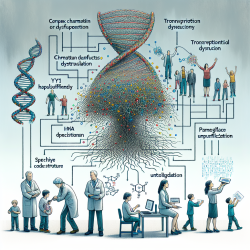Introduction
As practitioners dedicated to creating optimal outcomes for children, it is crucial to stay informed about the latest research and evidence-based strategies. One such area of interest is the human papillomavirus (HPV) vaccination, particularly in the context of school entry requirements. A recent study titled "Improving United States HPV vaccination rates: Factors predictive of parental attitudes towards middle school entry requirements" provides valuable insights into parental attitudes and the factors influencing these attitudes. This blog will explore how practitioners can leverage the findings of this study to enhance their skills and encourage further research in this area.
Understanding Parental Attitudes
The study conducted by Desch et al. (2024) aimed to understand the factors predictive of parents' attitudes toward schools requiring the HPV vaccine for entry into middle school. The researchers recruited parents of adolescents aged 11-12 years to participate in an online survey. The study found that various demographic and psychosocial factors significantly influenced parental attitudes toward school entry requirements for the HPV vaccine.
Key Findings and Implications
Some of the key findings from the study include:
- Demographic factors such as gender, political affiliation, urban/rural setting, and education level were significantly associated with parental attitudes.
- Psychosocial factors, including perceived social norms, perceived benefits, and perceived risks, played a crucial role in shaping parental attitudes.
- Perceived social norms emerged as the strongest predictor of positive attitudes toward school entry requirements.
These findings have several implications for practitioners working in the field of speech language pathology and related disciplines:
- Tailored Communication: Practitioners can use these insights to tailor their communication strategies when discussing HPV vaccination with parents. Understanding the demographic and psychosocial factors that influence parental attitudes can help practitioners address specific concerns and provide targeted information.
- Promoting Social Norms: Given the strong influence of perceived social norms, practitioners can play a role in promoting positive social norms around HPV vaccination. By fostering a supportive community environment and highlighting the benefits of vaccination, practitioners can encourage parents to adopt positive attitudes toward school entry requirements.
- Addressing Barriers: Practitioners can work to identify and address barriers that may hinder parental acceptance of HPV vaccination. By understanding the perceived risks and benefits, practitioners can provide accurate information and dispel myths or misconceptions surrounding the vaccine.
Encouraging Further Research
While the study provides valuable insights, it also highlights the need for further research in this area. Practitioners can contribute to the advancement of knowledge by engaging in research initiatives and collaborating with researchers to explore additional factors influencing parental attitudes toward HPV vaccination. By actively participating in research, practitioners can help shape evidence-based practices and policies that promote optimal health outcomes for children.
Conclusion
As practitioners committed to data-driven decision-making and creating positive outcomes for children, it is essential to stay informed about the latest research and leverage evidence-based strategies. The study on parental attitudes toward HPV vaccination school entry requirements provides valuable insights that can enhance practitioner skills and inform communication strategies. By understanding the factors influencing parental attitudes and promoting positive social norms, practitioners can contribute to increasing HPV vaccination rates and improving public health outcomes.
To read the original research paper, please follow this link: Improving United States HPV vaccination rates: Factors predictive of parental attitudes towards middle school entry requirements.










